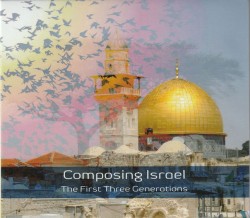 Composing Israel – The First Three Generations
Composing Israel – The First Three Generations
Various Artists
Neuma 177 (neumarecords.org)
Ten compositions spanning six decades present an overview of “the first three generations” of Israeli composers, variously performed by 24 musicians including members of the Israel Philharmonic Orchestra and five different pianists.
Toccata, Op.34, No.5 for piano (1943) is a wild, whirlwind dance by Paul Ben-Haim (né Paul Frankenburger, 1897-1984), a German refugee who helped found the “Eastern-Mediterranean School” of Israeli composition. German refugee Tzvi Avni (né Hermann Steinke, b.1927) studied with Ben-Haim and dedicated his Capriccio for piano (1955, rev.1975) to his mentor. Like Toccata, it embraces the volatile rhythms of Middle-Eastern music.
Arabesque No.2 for flute and harp (1973) by Ben-Haim student Ami Maayani (1936-2019) mixes Arabic rhythms with glissandi suggesting quarter-tones in its exultation of exoticism. Bashrav for chamber orchestra (2004) by Betty Olivero (b.1954), based on classic Persian music, while clearly Middle-Eastern in mood and materials, is less “folkish,” filled with explosive bursts and sudden silences.
I enjoyed all these much more than the non-Middle-Eastern-sounding piano pieces by Abel Ehrlich (1915-2003), Arie Shapira (1943-2015) and Ari Ben-Shabetai (b.1954) or the electronic collage of Bedouin children speaking by Tsippi Fleischer (b.1946), all dating from the 1980s.
In the 19-minute Wire for soprano and chamber ensemble (1986) by Oded Zehavi (b.1961), Denise Lundine keens a Hebrew poem, her “voice crying in the wilderness” over bursting percussion, the French horn emulating liturgical shofar (ram’s horn) elephantine trumpetings making this, by far the CD’s longest work, also its most “Jewish.”



